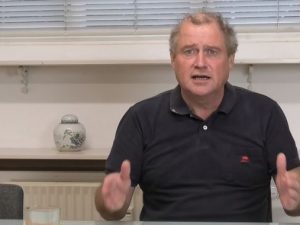Franco Persio Bocchetto,
Foreign Director for Bonifica S.p.A, Italy.
Video; english transcript

Italy-China Alliance for Transaqua
This is an edited transcript of a presentation by Franco Persio Bocchetto describing the Transaqua project to the Nov. 25-26 Schiller Institute Conference.
Transcript
Good afternoon to everybody, and to Ladies and Gentleman. I’m very glad to be here at this very interesting conference. I was really amazed listening this morning, especially to the speeches of Schiller Institute President Helga Zepp-LaRouche, and the one of the enthusiastic Professor He Wenping. And also I was interested in hearing the speech of Professor Askary, who introduced the Transaqua project that I would like to show and present here.
The Transaqua Project
The Transaqua project is perfectly in line with the vision of this conference, which is “To Fulfill the Dream of Mankind.” Transaqua, as maybe you know, was conceived more or less about 30 years ago, by our firm Bonifica. Perhaps at that time, it was too innovative; maybe in that time nobody was really interested in developing Africa. But nowadays conditions are really different and maybe this is the time to revive the project: Maybe we can call it “Transaqua 2.0” in order to start the development of this great dream for Africa.
Maybe most people think Transaqua is only a problem of transferring water from the Congo Basin to Lake Chad, but this is not the vision of Transaqua. First of all, everything starts from the problems that are related to Lake Chad. We are going to show you the actual situation of Lake Chad.
Lake Chad was one of the largest endorheic lakes in the world, and maybe the largest in Africa. The lake is situated in the Sahel region, at the crossing of the borders of four countries: Niger, Chad, Nigeria, and Cameroon. The total catchment area of Lake Chad is very huge: 2,434,000 sq km. Eight countries, including Algeria, Cameroon, Central African Republic, Chad, Libya, Niger, Nigeria, and Sudan are using the water resources from Lake Chad. The main inflows of Lake Chad are from the Chari River, and Chari and Longone River, and the main outflows are evaporation and infiltration. For this reason, it’s an endorheic lake, because it does not drain to the sea.
The Chari River and Longone River flow from south to north, and this is the actual Lake Chad. The lake basin has a very unstable equilibrium as there is no surplus water flowing to the sea. The only outflows are infiltration and evaporation. If water is used upstream, the lake cannot but shrink.
Lake Chad always had great oscillations, due to natural climatic fluctuations. Now, especially in this period of climate change, we must follow very closely what will be the future of Lake Chad. Lake Chad is suffering from the increase in population and subsequent water consumption, mainly for irrigation, and in addition, the decrease of rainfall. Lake Chad’s surface in 1973 was more or less 25,000 sq. km. As you see, in 2015, it decreased to 2,500 sq. km, while the population within the basin has grown from 8 million to 30 million people, more or less.
As a consequence of this drought and drying up of the lake, agriculture development increases pollution, ecological destruction, and extinction of rare species. The economy of the surrounding countries and region is severely threatened by reduction of the lake’s surface levels and volumes. Average food production and household purchasing power have been continuously reduced since the 1980s. Humanitarian, ecological, and economic crises are developing rapidly as the volume and surface of Lake Chad are drastically reduced at an alarming and accelerated pace.
Also, it’s important to show the evidence that in this region, the consequences of this are also all the problems related to Boko Haram, which is really active in this region due to the poverty of this region.
How to mitigate the Lake Chad drought: Well, thinking of the problems of Lake Chad, we have to think about the future. And the future in 30 to 50 years will be very, very dramatic for Africa in a certain way. As you see, it is forecast that real growth of the population, between today and the year 2200, will grow by 400%. So the problem is, what will happen when, within 30-40 years you will have the doubling of the population in Africa, and also in those Sahel regions.
We heard today in the earlier speeches, about the New Deal and the optimistic vision of Chinese President Xi Jinping, and we really hope that, due to the positive strength of China, they will really succeed in helping the world help to develop, and that these regions will have help from the Chinese for development. There are a lot of projects that are going on as Mr. Askary has showed us in the context for all of Africa. But, it is important, also to set up and improve the Transaqua project in Central Africa, in the middle of Africa, the part which is poorest and where the desert is continuing to make inroads.
The consequence of not doing this is a huge migration into the rich countries, and of course, Italy and Europe are suffering from these consequences. Most of the people come from the Sahel region, so I think that Europe has to help to improve the Transaqua project, in order to develop all these countries, and bring food, agriculture, and fisheries as a way to eliminate poverty in this region.
Over the years, the Lake Chad Basin Commission, created by the states around Lake Chad has really done great work in facing up to the shrinking of the lake, and for the realization of numerous national and transnational projects, to optimize the use of water resources and mitigate possible disputes between the states.
What to do next? What will the next challenges be for the Lake Chad Basin Commission? First of all, in the medium term, there are projects that are going on to mitigate the Lake Chad drought, of course, projects that tend to sustain the existence of people, improve the efficiency of water use, through new research, innovative organization, based on the use of smart technologies to improve the efficiency of system coordination and control. First of all, a very big monitoring system should be set up in order to control the consequences of climate change, control all the problems related to agricultural use, and control the consequences of national and transnational projects that are being done in this region.
We can be very optimistic, but due to the growth of the population, the long-term measures cannot be other than to think how to transfer large volumes of water from the Congo River Basin to Lake Chad.
Well, water transfer to drying up endorheic lakes is not merely a “nature conservation measure.” Environment and wildlife deserve to be protected—human beings, too. A drying endorheic lake is proof that the water resources in its catchment area are overexploited with respect to incoming run-off. Transfering water from adjacent river basins that have surplus water flowing into the sea, is a way of increasing water availability, especially for agriculture, in the context of the increasing population and declining rainfall, and to restore wildlife.
When water is in short supply in a given place, either you bring it there, or people will migrate elsewhere.
Near Lake Chad, there is an immense, scarcely populated river basin, which discharges into the Atlantic Ocean an average of 40,000 cubic meters/second—the equivalent to 1,250 billion m3 /year. That discharge is 200 times the discharge of the Main River [in Germany], or 14 times that of the Rhine at its mouth. How much of this volume could be possibly and safely diverted into Lake Chad has yet to be studied.
Can we think of a “win-win” project, where all countries involved have their advantages, which is perhaps, one of the basic conditions for developing this project?
Bringing water from the Congo River Basin to the thirsty Chad region and increasing irrigated agriculture, restoring the lake, producing hydropower and improving inter-African transport and commerce, is the vision of this Transaqua Project.
A canal would have to intercept part of the discharge of the right-hand tributaries of the Congo River, and convey them across the watershed between the Congo Basin and the Chari Basin. The diverted flow would reach Lake Chad through one of the Chari tributaries, properly reshaped. A very preliminary estimate gives an amount up to 100 billion m3 /year could be diverted. That this less than 8% of the Congo discharge, ensuring thus the restoration of Lake Chad and irrigation of up to 3 million hectares.
In its fall toward Chad, the diverted flow could be used for hydropower production. Along the canal, a road should be built which would become the backbone of inter-African land transport. The hypothesis that the canal could also be suitable for navigation has been made. Those ideas stemming from the early 1920s, have been studied by Bonifica, and are presently being considered by the Lake Chad Basin Commission as a possible project for the future.
The idea of Bonifica is to transfer about 100 million cubic meters of water per year from the Congo River Basin to the Lake Chad and Sahel district. This is the Congo Basin as you can see in red, which is the alignment more or less of the canal. You cross the watershed and you go into the water catchment area of the River Chari.
What is important to note is that the Transaqua formula is not simply to replenish Lake Chad, but to give access to drinking water, revive agricultural activity, irrigation, fish farming, a navigable waterway, trade, transport, regulate flows, produce electric power, river ports, commerce, and road connections—thus creating an economic development system along the Transaqua waterway.
With the regeneration of Lake Chad’s natural resources, we can show the shape of the lake in 2087. Characteristic of this project is that navigable infrastructure systems can be realized through modules. We don’t need to realize the whole project at the same time, so we start from the part which is most near to the watershed, and the development of the first 500 km of the canal.
The Transaqua water project is a combination of situations. In order to produce hydropower, we will construct small dams along the tributaries of the river, in order to catch some part of the water for the Transaqua canal. By connecting different lakes with canals, we can realize a waterway which will have a maximum extent of up to 2,400 km, reaching Lake Tanganyika on the east side of Africa.
Road connection: As you can see, the Transaqua corridor intersects the Lagos-Mombasa Road, which is one of the principal roads that was shown by Professor Askary in his speech. And as you can see, in the Mombasa-Nairobi link, it is one of the hubs of the One Belt, One Road project.
It is very interesting to think that this Transaqua Project can become one of the projects that can be developed within the One Belt, One Road project.
Some final considerations: Having for years pursued a dream, now is the time to take action. From this point of view, what is interesting and new is the fact that the Chinese have begun to get interested in the project. Last year, a Memorandum of Understanding (MOU) was signed between the Lake Chad Basin Commission, and ChinaPower, which is one of the big infrastructure companies of China. The scope of the MOU was to start the feasibility study of the water transfer project, by trying to construct one of the first elements of the project, which is the CIMA Project. I don’t have time now to explain this CIMA project, but it is certainly one of the modules of Transaqua, although it is only part of it, because the CIMA project, developed by the Canadian CIMA company, is a project to pump water from the Ubangi River over the watershed into the Chari River, which is a different vision from Transaqua, which is to construct a corridor crossing Africa, and bringing development to all the regions that are crossed by the project.
It is important at this point to show that Bonifica, in the context of the signing of this MOU, decided to go to China and to speak to ChinaPower, in order to offer the collaboration of Europeans, of Italians, to jointly develop the feasibility study. We found a great interest from the Chinese, so we signed an MOU and now we are taking action in order to jointly develop this feasibility project together with the Chinese. This may be the first break in the construction of this important infrastructure in the center of Africa.
Thank you. [applause]







